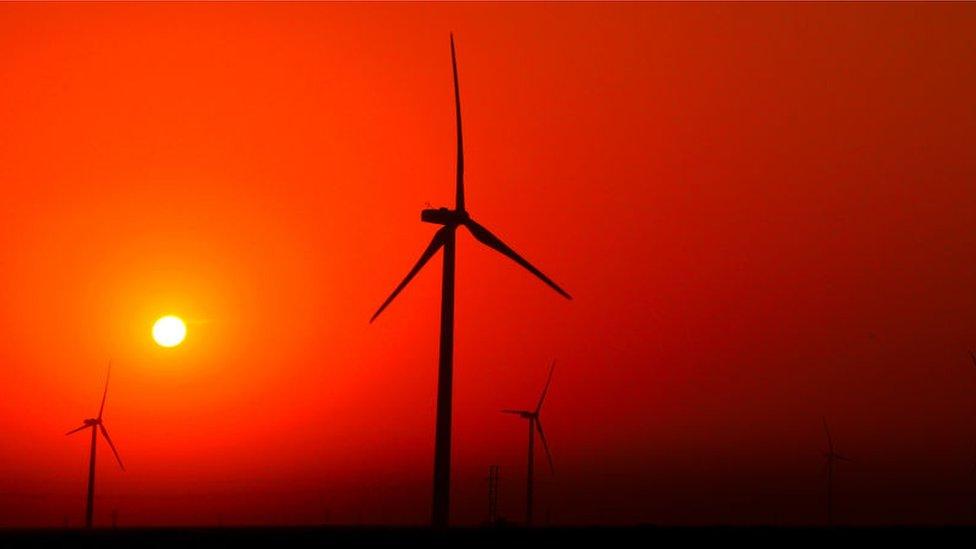Climate change: World using less fossil fuels to produce electricity
- Published
- comments

The world will likely use less fossil fuels to produce electricity this year - instead relying more on renewable energy sources.
That's according to a new report from energy analyst Ember's Global Electricity Review.
This move would be a "turning point" for planet-friendly energy, and help in the fight against climate change.
It would be the first time ever that there has been an annual drop in the use of coal, oil and gas to generate electricity on purpose, and not due to other factors like a global recession or pandemic.
During a recession people have less money and so are likely to reduce their use of energy as much as possible, while during the pandemic demand for electricity decreased as lots of machinery, computers, lights and heaters that were being used in offices and schools were all turned off.
This new study looks at electricity data from 78 countries, who altogether use more than 90% of all electricity produced each year.
It has said that one major reason behind the change is a boom in renewable energy, led mainly by China - a country which has long been the biggest emitter of carbon dioxide (CO2) emissions.
Last year around 50% of the global addition of wind power and 40% of the world's new solar came from from the country.
Ember's report also indicates that significant progress is now being made in reducing the role of fossil fuels in power production, not only in China but other countries too.
Renewable energy is made from resources that nature will replace, like wind, water and sunshine.
Renewable energy is also called "clean energy" or "green power" because it doesn't pollute the air or the water.
Non-renewable energy includes coal, gas and oil, also known as fossil fuels or hydrocarbons.
Most cars, trains and planes use non-renewable energy. They are made by burning fossil fuels to create energy.
Why is this good news for the environment?
Global warming is the rise in temperature of the earth's atmosphere, and one of the causes is burning fossil fuels like coal, oil and gas.
But if less of these are being used, then fewer gases would be released during energy production.
Electricity is the single biggest contributor to global warming, responsible for over a third of energy-related carbon emissions in 2021.
When you stop adding more fossil fuels to generate your electricity, you start seeing a fall in emissions.
Wind and solar now produce 12% of global electricity with enough wind turbines added in 2022 to power almost all of the UK.
The study said that renewables are set to meet all growth in demand this year.
Phasing out coal, oil and gas in this sector is seen as critical in helping the world avoid dangerous levels of climate change.
Enough wind energy was added globally to almost power the whole UK
What changes were made in 2022?
The report finds that electricity produced last year was the 'cleanest' ever made, with clean sources producing 39% of global electricity in 2022 when taken together with nuclear and hydropower.
Over sixty countries now generate more than 10% of their electricity from wind and solar, with all clean electricity sources (renewables and nuclear) reaching 39% of global electricity, a new record high.
Around the world, solar power grew by 24% last year, enough to meet the annual demands of a country as big as South Africa.
However as overall demand for electricity rose, not all of it is able to be met from clean sources.
There were problems with nuclear energy with many French reactors offline, and last year Europe's rivers were too low in many places for hydro energy to be generated.
This meant coal use increased, pushing carbon emissions up.
China added around 40% of the world's new solar panels last year, with large numbers of rooftop installations
What can we expect to happen this year?
The report says that in 2023 the growth of wind and solar will be greater than the rise in demand, and so they should be able to produce much of the electricity needed around the world.
Malgorzata Wiatros-Motyka the report's lead author has said that carbon emissions are also falling in other areas due to cleaner energy, for example the rise in electric vehicles and use of heat pumps.
While the fall in fossil fuel emissions this year is expected to be only around 0.3% - the authors believe the drop will continue to increase more in future years.
Key to this will also be a decrease in the use of gas, with countries like Brazil reducing their use by 46% in 2022.
Meeting the rising demand for electricity with renewables is key to curbing fossil fuel use
Dave Jones, another of the report authors, said: "We now have reached this next turning point of starting to see a new era of falling fossil fuel power sector emissions.
"We know that wind and solar are the answer and we've just got to get on with a roadmap for building them as quickly as possible."
But, he added that there is still a lot of work to be done when it comes to reducing the use of coal, with China one of the world's biggest user of coal power.
In many countries around the world it has taken decades to fully phase out coal power, and even in the UK it is still being used a bit - 43 years after the plan to stop using it came into force.
Mr Jones added: "In order to reach clean energy goals we don't have 40 or even 30 years, we need to fully decarbonize electricity in a much shorter time."
- Published20 March 2023
- Published28 January 2021
- Published15 April 2020
